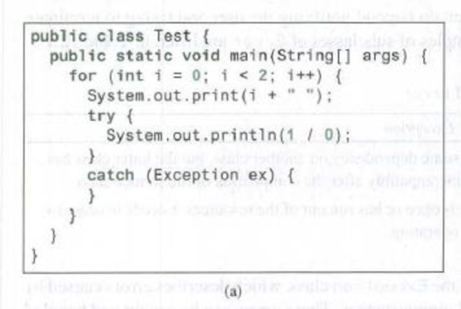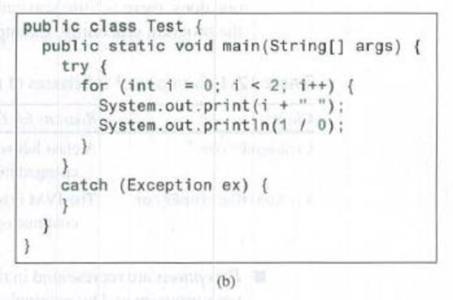
Introduction to Java Programming and Data Structures, Comprehensive Version Plus MyProgrammingLab with Pearson EText -- Access Card Package
11th Edition
ISBN: 9780134694511
Author: Liang, Y. Daniel
Publisher: Pearson Education Canada
expand_more
expand_more
format_list_bulleted
Textbook Question
Chapter 12.2, Problem 12.2.6CP
Show the output of the following code:


Expert Solution & Answer
Want to see the full answer?
Check out a sample textbook solution
Students have asked these similar questions
reminder it an exercice not a grading work
GETTING STARTED
Open the file SC_EX19_EOM2-1_FirstLastNamexlsx, available for download from the SAM website.
Save the file as SC_EX19_EOM2-1_FirstLastNamexlsx by changing the “1” to a “2”.
If you do not see the .xlsx file extension in the Save As dialog box, do not type it. The program will add the file extension for you automatically.
With the file SC_EX19_EOM2-1_FirstLastNamexlsx still open, ensure that your first and last name is displayed in cell B6 of the Documentation sheet.
If cell B6 does not display your name, delete the file and download a new copy from the SAM website.
Brad Kauffman is the senior director of projects for Rivera Engineering in Miami, Florida. The company performs engineering projects for public utilities and energy companies. Brad has started to create an Excel workbook to track estimated and actual hours and billing amounts for each project. He asks you to format the workbook to make the…
Need help completing this algorithm here in coding! 2
Whats wrong the pseudocode here??
Chapter 12 Solutions
Introduction to Java Programming and Data Structures, Comprehensive Version Plus MyProgrammingLab with Pearson EText -- Access Card Package
Ch. 12.2 - Prob. 12.2.1CPCh. 12.2 - Prob. 12.2.2CPCh. 12.2 - Prob. 12.2.3CPCh. 12.2 - Prob. 12.2.4CPCh. 12.2 - Prob. 12.2.5CPCh. 12.2 - Show the output of the following code:Ch. 12.3 - Prob. 12.3.1CPCh. 12.3 - Prob. 12.3.2CPCh. 12.4 - Prob. 12.4.1CPCh. 12.4 - Prob. 12.4.2CP
Ch. 12.4 - Prob. 12.4.3CPCh. 12.4 - Prob. 12.4.4CPCh. 12.4 - Prob. 12.4.5CPCh. 12.4 - Prob. 12.4.6CPCh. 12.4 - What is displayed when running the following...Ch. 12.4 - Prob. 12.4.8CPCh. 12.4 - What does the method getMessage() do?Ch. 12.4 - What does the method printStackTrace() do?Ch. 12.4 - Prob. 12.4.11CPCh. 12.4 - Prob. 12.4.12CPCh. 12.5 - Prob. 12.5.1CPCh. 12.6 - Prob. 12.6.1CPCh. 12.7 - Prob. 12.7.1CPCh. 12.8 - Prob. 12.8.1CPCh. 12.9 - Prob. 12.9.1CPCh. 12.9 - Prob. 12.9.2CPCh. 12.10 - What is wrong about creating a File object using...Ch. 12.10 - How do you check whether a file already exists?...Ch. 12.10 - Can you use the File class for I/O? Does creating...Ch. 12.11 - Prob. 12.11.1CPCh. 12.11 - Prob. 12.11.2CPCh. 12.11 - Prob. 12.11.3CPCh. 12.11 - Prob. 12.11.4CPCh. 12.11 - What will happen if you attempt to create a...Ch. 12.11 - Prob. 12.11.6CPCh. 12.11 - Suppose you enter 45 57, 8 789, then press the...Ch. 12.11 - Prob. 12.11.8CPCh. 12.12 - How do you create a Scanner object for reading...Ch. 12.13 - Prob. 12.13.1CPCh. 12.13 - Simplify the code in lines 20-28 as follows: 1....Ch. 12 - Prob. 12.1PECh. 12 - (InputMismatchException) Write a program that...Ch. 12 - (ArrayIndexOutOfBoundsException) Write a program...Ch. 12 - (IllegalArgumentException) Modify the Loan class...Ch. 12 - (IllegalTriangleException) Programming Exercise...Ch. 12 - (NumberFormatException) Listing 6.8 implements the...Ch. 12 - Prob. 12.7PECh. 12 - Prob. 12.8PECh. 12 - Prob. 12.9PECh. 12 - Prob. 12.10PECh. 12 - Prob. 12.11PECh. 12 - (Reformat Java source code) Write a program that...Ch. 12 - (Count characters, words, and lines in a file)...Ch. 12 - (Process scores in a text file) Suppose a text...Ch. 12 - (Write/read data) Write a program to create a file...Ch. 12 - Prob. 12.16PECh. 12 - (Game: hangman) Rewrite Programming Exercise 7.35....Ch. 12 - Prob. 12.18PECh. 12 - (Count words) Write a program that counts the...Ch. 12 - Prob. 12.20PECh. 12 - (Data sorted?) Write a program that reads the...Ch. 12 - Prob. 12.22PECh. 12 - (Process scores in a text file on the Web) Suppose...Ch. 12 - (Create large dataset) Create a data file with...Ch. 12 - (Create a directory) Write a program that prompts...Ch. 12 - Prob. 12.26PECh. 12 - (Replace words) Suppose you have a lot of files in...Ch. 12 - (Rename files) Suppose you have a lot of files in...Ch. 12 - (Rename files) Suppose you have several files in a...Ch. 12 - (Occurrences of each letter) Write a program that...Ch. 12 - (Baby name popularity ranking) The popularity...Ch. 12 - (Ranking summary) Write a program that uses the...
Additional Engineering Textbook Solutions
Find more solutions based on key concepts
In the following exercises, write a program to carry out the task. The program should use variables for each of...
Introduction To Programming Using Visual Basic (11th Edition)
Calories Burned Running on a particular treadmill you burn 3.9 calories per minute. Design a program that uses ...
Starting Out with Programming Logic and Design (5th Edition) (What's New in Computer Science)
This optional Google account security feature sends you a message with a code that you must enter, in addition ...
SURVEY OF OPERATING SYSTEMS
What is the difference between operating system software and application software?
Starting Out With Visual Basic (8th Edition)
Describe a method that can be used to gather a piece of data such as the users age.
Web Development and Design Foundations with HTML5 (8th Edition)
Determine the maximum weight of the crate that can be suspended from cables AB, AC, and AD so that the tension ...
INTERNATIONAL EDITION---Engineering Mechanics: Statics, 14th edition (SI unit)
Knowledge Booster
Learn more about
Need a deep-dive on the concept behind this application? Look no further. Learn more about this topic, computer-science and related others by exploring similar questions and additional content below.Similar questions
- Help! how do I fix my python coding question for this? (my code also provided)arrow_forwardNeed help with coding in this in python!arrow_forwardIn the diagram, there is a green arrow pointing from Input C (complete data) to Transformer Encoder S_B, which I don’t understand. The teacher model is trained on full data, but S_B should instead receive missing data—this arrow should not point there. Please verify and recreate the diagram to fix this issue. Additionally, the newly created diagram should meet the same clarity standards as the second diagram (Proposed MSCATN). Finally provide the output image of the diagram in image format .arrow_forward
- Please provide me with the output image of both of them . below are the diagrams code make sure to update the code and mentionned clearly each section also the digram should be clearly describe like in the attached image. please do not provide the same answer like in other question . I repost this question because it does not satisfy the requirment I need in terms of clarifty the output of both code are not very well details I have two diagram : first diagram code graph LR subgraph Teacher Model (Pretrained) Input_Teacher[Input C (Complete Data)] --> Teacher_Encoder[Transformer Encoder T] Teacher_Encoder --> Teacher_Prediction[Teacher Prediction y_T] Teacher_Encoder --> Teacher_Features[Internal Features F_T] end subgraph Student_A_Model[Student Model A (Handles Missing Values)] Input_Student_A[Input M (Data with Missing Values)] --> Student_A_Encoder[Transformer Encoder E_A] Student_A_Encoder --> Student_A_Prediction[Student A Prediction y_A] Student_A_Encoder…arrow_forwardWhy I need ?arrow_forwardHere are two diagrams. Make them very explicit, similar to Example Diagram 3 (the Architecture of MSCTNN). graph LR subgraph Teacher_Model_B [Teacher Model (Pretrained)] Input_Teacher_B[Input C (Complete Data)] --> Teacher_Encoder_B[Transformer Encoder T] Teacher_Encoder_B --> Teacher_Prediction_B[Teacher Prediction y_T] Teacher_Encoder_B --> Teacher_Features_B[Internal Features F_T] end subgraph Student_B_Model [Student Model B (Handles Missing Labels)] Input_Student_B[Input C (Complete Data)] --> Student_B_Encoder[Transformer Encoder E_B] Student_B_Encoder --> Student_B_Prediction[Student B Prediction y_B] end subgraph Knowledge_Distillation_B [Knowledge Distillation (Student B)] Teacher_Prediction_B -- Logits Distillation Loss (L_logits_B) --> Total_Loss_B Teacher_Features_B -- Feature Alignment Loss (L_feature_B) --> Total_Loss_B Partial_Labels_B[Partial Labels y_p] -- Prediction Loss (L_pred_B) --> Total_Loss_B Total_Loss_B -- Backpropagation -->…arrow_forward
- Please provide me with the output image of both of them . below are the diagrams code I have two diagram : first diagram code graph LR subgraph Teacher Model (Pretrained) Input_Teacher[Input C (Complete Data)] --> Teacher_Encoder[Transformer Encoder T] Teacher_Encoder --> Teacher_Prediction[Teacher Prediction y_T] Teacher_Encoder --> Teacher_Features[Internal Features F_T] end subgraph Student_A_Model[Student Model A (Handles Missing Values)] Input_Student_A[Input M (Data with Missing Values)] --> Student_A_Encoder[Transformer Encoder E_A] Student_A_Encoder --> Student_A_Prediction[Student A Prediction y_A] Student_A_Encoder --> Student_A_Features[Student A Features F_A] end subgraph Knowledge_Distillation_A [Knowledge Distillation (Student A)] Teacher_Prediction -- Logits Distillation Loss (L_logits_A) --> Total_Loss_A Teacher_Features -- Feature Alignment Loss (L_feature_A) --> Total_Loss_A Ground_Truth_A[Ground Truth y_gt] -- Prediction Loss (L_pred_A)…arrow_forwardI'm reposting my question again please make sure to avoid any copy paste from the previous answer because those answer did not satisfy or responded to the need that's why I'm asking again The knowledge distillation part is not very clear in the diagram. Please create two new diagrams by separating the two student models: First Diagram (Student A - Missing Values): Clearly illustrate the student training process. Show how knowledge distillation happens between the teacher and Student A. Explain what the teacher teaches Student A (e.g., handling missing values) and how this teaching occurs (e.g., through logits, features, or attention). Second Diagram (Student B - Missing Labels): Similarly, detail the training process for Student B. Clarify how knowledge distillation works between the teacher and Student B. Specify what the teacher teaches Student B (e.g., dealing with missing labels) and how the knowledge is transferred. Since these are two distinct challenges…arrow_forwardThe knowledge distillation part is not very clear in the diagram. Please create two new diagrams by separating the two student models: First Diagram (Student A - Missing Values): Clearly illustrate the student training process. Show how knowledge distillation happens between the teacher and Student A. Explain what the teacher teaches Student A (e.g., handling missing values) and how this teaching occurs (e.g., through logits, features, or attention). Second Diagram (Student B - Missing Labels): Similarly, detail the training process for Student B. Clarify how knowledge distillation works between the teacher and Student B. Specify what the teacher teaches Student B (e.g., dealing with missing labels) and how the knowledge is transferred. Since these are two distinct challenges (missing values vs. missing labels), they should not be combined in the same diagram. Instead, create two separate diagrams for clarity. For reference, I will attach a second image…arrow_forward
arrow_back_ios
SEE MORE QUESTIONS
arrow_forward_ios
Recommended textbooks for you
 C++ Programming: From Problem Analysis to Program...Computer ScienceISBN:9781337102087Author:D. S. MalikPublisher:Cengage Learning
C++ Programming: From Problem Analysis to Program...Computer ScienceISBN:9781337102087Author:D. S. MalikPublisher:Cengage Learning Microsoft Visual C#Computer ScienceISBN:9781337102100Author:Joyce, Farrell.Publisher:Cengage Learning,
Microsoft Visual C#Computer ScienceISBN:9781337102100Author:Joyce, Farrell.Publisher:Cengage Learning, C++ for Engineers and ScientistsComputer ScienceISBN:9781133187844Author:Bronson, Gary J.Publisher:Course Technology Ptr
C++ for Engineers and ScientistsComputer ScienceISBN:9781133187844Author:Bronson, Gary J.Publisher:Course Technology Ptr EBK JAVA PROGRAMMINGComputer ScienceISBN:9781337671385Author:FARRELLPublisher:CENGAGE LEARNING - CONSIGNMENT
EBK JAVA PROGRAMMINGComputer ScienceISBN:9781337671385Author:FARRELLPublisher:CENGAGE LEARNING - CONSIGNMENT

C++ Programming: From Problem Analysis to Program...
Computer Science
ISBN:9781337102087
Author:D. S. Malik
Publisher:Cengage Learning

Microsoft Visual C#
Computer Science
ISBN:9781337102100
Author:Joyce, Farrell.
Publisher:Cengage Learning,

C++ for Engineers and Scientists
Computer Science
ISBN:9781133187844
Author:Bronson, Gary J.
Publisher:Course Technology Ptr

EBK JAVA PROGRAMMING
Computer Science
ISBN:9781337671385
Author:FARRELL
Publisher:CENGAGE LEARNING - CONSIGNMENT
What Are Data Types?; Author: Jabrils;https://www.youtube.com/watch?v=A37-3lflh8I;License: Standard YouTube License, CC-BY
Data Types; Author: CS50;https://www.youtube.com/watch?v=Fc9htmvVZ9U;License: Standard Youtube License